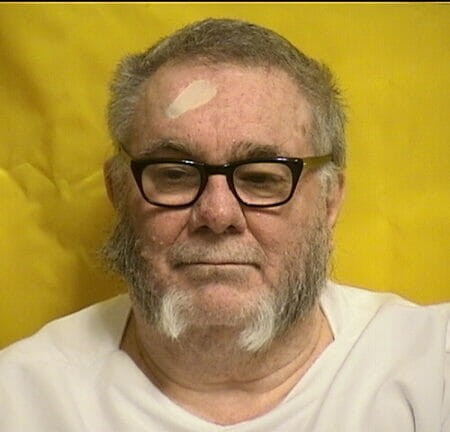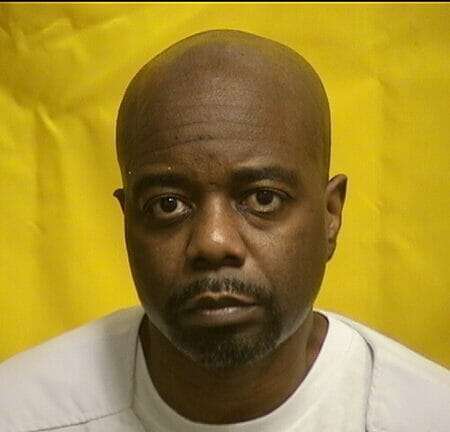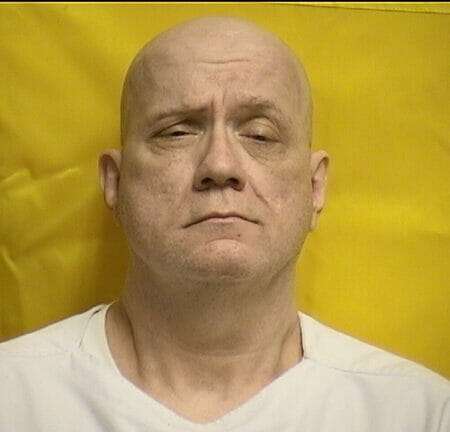James Hanna was sentenced to death by the State of Ohio for a prison murder. According to court documents James Hanna was serving a life sentence for the murder of a convenience store clerk when he murdered his cell mate. James Hanna would stab the victim in the eye before beating and torturing the man for two hours. James Hanna would be convicted and sentenced to death.
Ohio Death Row Inmate List
James Hanna 2021 Information
Number A152169
DOB 07/12/1949
Gender Male Race White
Admission Date 07/20/1978
Institution Chillicothe Correctional Institution
Status INCARCERATED
James Hanna More News
On or about August 18, 1997, Copas was moved into appellant’s cell. From the outset, Copas and appellant did not get along. Appellant was upset because prison authorities had moved Copas into his cell without appellant’s prior knowledge, because Copas had altered the condition of the cell, and because Copas had used appellant’s property without his permission.
{¶ 5} Around August 20, 1997, Ricardo Lee, another inmate, asked appellant to allow Copas to remain in appellant’s cell until Lee and Copas could become cellmates. According to Lee, appellant “acted as if he was just tolerating him as long as he could until they could move him.” The next day, appellant told Lee that “Mr. Copas had bothered his TV set and broken it and that * * * he couldn’t really tolerate him anymore, that [he] should do whatever [he] had to do to help him move out of the cell.” During a third conversation, on the day before the murder, appellant told Lee that he had “better do something because his wick was getting short.”
{¶ 6} On August 21, when appellant returned to his cell, he found the cell door open, and some of his belongings were “laying about” or “stolen.” Appellant was upset, since “you don’t leave your cell door open so that someone can come in and take your cellmate’s belongings.” Around 9:15 p.m., Copas returned to the cell, appeared intoxicated, crawled into his top bunk, and then vomited.
{¶ 7} Appellant decided “that he had had enough.” Around 4:00 a.m. or 5:00 a.m. on August 22, 1997, appellant “took a paintbrush, sharpened * * * the tip of it down, took matches and lit the end that he had sharpened as to stiffen it up so that it would be brittle.” Appellant created another weapon by taking “a lock off of Mr. Copas’ lock box” and then placing it inside a sock. While Copas was asleep, appellant “stood up and plunged the paintbrush handle into Mr. Copas’ eye,” and the handle broke off. Appellant “didn’t mean for it to break; * * * he wanted it to go further in than what it did, but it broke off.” Appellant said that he did not stick Copas in the ear “[b]ecause the ear is too hard. You would use an ice pick in the ear. The eye is much softer.”
{¶ 8} After being attacked, Copas “rose up out of bed” and asked, “Why the hell did you do that?” Then, appellant struck Copas in the head with the lock and also “took his fist and struck” Copas. Copas passed out and fell over the television set at the foot of the bed. At that point, appellant “flushed the paintbrush handle remains and the sock down the toilet, placed the padlock back on the locker box, and then sat back in his bed” and smoked a cigarette.
{¶ 9} Around 6:00 a.m., Copas arose out of his unconscious condition and “jumped up, ran to the cell door and started screaming that, ‘My celly’s trying to kill me.’ ” Doug Stewart, a corrections officer at LCI, heard yelling, went to Copas’s cell, and saw Copas “standing at the door, bleeding.” Copas was taken to the prison infirmary. In the meantime, appellant was backed out of his cell and handcuffed. When a guard asked him what happened, appellant replied, “I told them not to put him in here with me.”
{¶ 10} Upon arriving at the prison infirmary, Copas told Linda Young, a registered nurse, that “he was shanked in the head and hit with a battery in a sock.” Copas was transferred to the Middletown Regional Hospital about thirty minutes later.
{¶ 11} Dr. Ralph Talkers, an emergency physician at Middletown, treated Copas for head lacerations; “his right eye was extremely swollen,” consistent with an assault. However, Copas was not treated for stab wounds, since neither his medical records nor Copas himself had indicated that he had been stabbed. Dr. Talkers examined Copas’s eye, but there was “no indication whatsoever” that there was a foreign object lodged in or behind his eye. Moreover, results of X-rays of the face and skull proved negative. Thus, Dr. Talkers concluded that Copas’s “eye was traumatized * * * because of the blunt injury” during the assault.
{¶ 12} According to Dr. Talkers, a CAT (computerized axial tomography) scan of Copas’s head was not conducted, since “the patient was awake and talking and did not have * * * focal neurological findings.” Moreover, Copas was “observed in the emergency room for approximately five hours” and never lost consciousness. Copas was sent back to the prison infirmary and arrived at around 1:45 p.m. on August 22.
{¶ 13} Dr. James McWeeney, the medical director at LCI, found that Copas was “very lucid,” and “his speech was clear and deliberate” when he examined Copas on August 23. According to Dr. McWeeney, Copas “did not exhibit any signs of an intracranial injury or severe head trauma.” However, Dr. McWeeney ordered an ophthalmology consult and a CAT scan.
{¶ 14} On August 26, 1997, Dr. Steven Katz, a neuro-ophthalmologist, examined Copas at the Corrections Medical Center. Copas’s eye was swollen, and there appeared to be “swelling or congestion in the socket behind the eye.” A CAT scan completed later that evening showed “a large foreign object * * * like a pen or pencil * * * lodged in the socket just behind the eye, inside the eye muscle cone.” According to Dr. Katz, “it appeared to penetrate the pons, which is part of the brain stem, and go back far enough to enter the cerebellum.”
{¶ 15} On August 27, 1997, neurosurgeons conducted a “pterional craniotomy” and removed the remnant of the paintbrush, which was approximately five inches long, from inside Copas’s head. Copas recovered “very quickly from surgery” and was treated with “broad-spectrum intravenous antibiotics” to fight possible infection. However, on September 5, 1997, his medical condition deteriorated. Copas died on September 10, 1997.
{¶ 16} Dr. Keith Norton, a Franklin County forensic pathologist and deputy coroner, concluded that Copas had suffered extensive brain injuries extending into the cerebellum. These injuries included bleeding surrounding the underside of the brain, swelling of the brain, insufficient blood flow to the brain’s nerve cells, and “bacterial colonies in the basilar meninges.” Dr. Norton stated that “the penetrating injury to the head” caused by the paintbrush was the cause of death.
{¶ 17} At trial, the prosecution introduced appellant’s letter to Dennis Borowski, an inmate at the Southern Ohio Correctional Facility (“SOCF”). In the letter, dated January 10, 1998, appellant stated, “Well, it’s like this Dennis, I caught a murder #1 case on my cellie at Lebanon. He was a maggot baby-raper-killer I found out, and those idiots of the administration there wouldn’t move him the hell out of my cell, so I took him out of his misery. I made him suffer pretty good too, because first of all, I stabbed one of his eyeballs up out of its socket, and then I beat all on his stupid-ass-head off-and-on for two (2) hours (4:00 a.m. to 6:00 a.m.) in the morning until count time when they came and got us both up out of the cell. -He lived for twenty-and-a-half (20 1/212 ) hours after that before he croaked.”
{¶ 18} Bryan Freeze, an inmate at LCI in August 1997, was appellant’s cellmate before Copas. Three or four days after the August 22 incident, Freeze and appellant were in the segregation unit at the prison. Freeze asked appellant about the attack. In response, appellant admitted stabbing Copas in the eye and said, “I tried to bash the mother fucker’s brains in.” Freeze asked appellant “why he had done it,” and appellant said, that Copas “had turned his TV off on him.”
{¶ 19} Barnard Williams, a state investigator, talked to Copas at the Middletown Regional Hospital on August 22, 1997. Copas said that prior to the attack, he had put on head phones and had put a white T-shirt over his eyes so that he could sleep better. He then “laid there for a couple of hours and was sleeping.” Then, Copas said, “I felt something hit my head, by my mouth area. I looked up, but I don’t know what [happened]. I saw [appellant’s] hand covered with a gauze, with a pencil like shank in it. He hit me with it and I sat up trying to protect myself.” Thereafter, appellant hit him with the lock in the sock. After he had been hit four or five times, Copas said, “I tried to plead with him but he kept hitting me.”
{¶ 20} Dr. Bruce Janiak, an emergency physician, testified by videotaped deposition that Copas should have received a CAT scan of his head during medical treatment on August 22, 1997. Dr. Janiak reached that opinion “because it’s well-known in the literature that in instances which I described, i.e., the head injury with questionable loss of consciousness and in addition the vomiting, that that would be an indication for a head CAT scan, and that’s the standard, * * * so I think it should have been.” Furthermore, Dr. Janiak stated, “I can say with 100 percent certainty that had a CAT scan been done, you would have seen the piece of wood and known that there was a foreign body.” Finally, Dr. Janiak testified that earlier removal of the wooden shaft from inside Copas’s head would have reduced the possibility of infection.
{¶ 21} Dr. Paul Schwetschenau, a neurosurgeon, agreed with the coroner’s findings that Copas had died of a brain infarction from a massive subarachnoid hemorrhage. He surmised that the hemorrhage was caused by “trauma to the blood vessels or bacterial weakening of the wall of the blood vessels.” In Dr. Schwetschenau’s opinion, a CAT scan would have “revealed the presence of a wooden object in Mr. Copas’s brain,” and its “earlier detection and removal would have significantly improved the chances of reducing the bacterial contamination and the bacterial growth.”
{¶ 22} Dr. Schwetschenau also reviewed Copas’s frontal X-ray of August 22 and identified “two very distinct parallel lines that are not natural and do not belong in anybody’s skull.” Dr. Schwetschenau testified, “I believe that this is the outline or the size of a straight or cylindrical object.”
{¶ 23} The grand jury indicted appellant for aggravated murder with prior calculation and design with two death penalty specifications. The specifications were for murder committed in a detention facility pursuant to R.C. 2929.04(A)(4), and for conviction of a prior purposeful killing pursuant to R.C. 2929.04(A)(5).
{¶ 24} Appellant was also indicted with a third specification for being a repeat violent offender as defined in R.C. 2929.01. In a second count, he was indicted for possession of a deadly weapon under detention and charged with an accompanying specification for being a repeat violent offender.
{¶ 25} The jury found appellant guilty of Count One and the R.C. 2929.04(A)(4) specification. Upon appellant’s election, the trial judge separately found appellant guilty of the R.C. 2929.04(A)(5) specification and the repeat violent offender specification. Count Two and the accompanying specification were dismissed.
{¶ 26} The jury recommended death for Copas’s murder. The trial court sentenced appellant to death for Copas’s murder and eight years for the repeat violent offender specification.
https://caselaw.findlaw.com/oh-supreme-court/1013491.html









